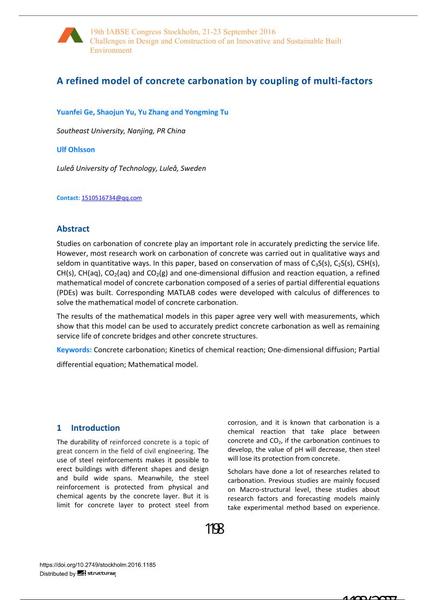A refined model of concrete carbonation by coupling of multi-factors

|
|
|||||||||||
Bibliografische Angaben
| Autor(en): |
Yuanfei Ge
(Southeast University, Nanjing, PR China)
Shaojun Yu (Southeast University, Nanjing, PR China) Zhang Yu (Southeast University, Nanjing, PR China) Yongming Tu (Southeast University, Nanjing, PR China) Ulf Ohlsson (Luleå University of Technology, Luleå, Sweden) |
||||
|---|---|---|---|---|---|
| Medium: | Tagungsbeitrag | ||||
| Sprache(n): | Englisch | ||||
| Tagung: | IABSE Congress: Challenges in Design and Construction of an Innovative and Sustainable Built Environment, Stockholm, Sweden, 21-23 September 2016 | ||||
| Veröffentlicht in: | IABSE Congress Stockholm, 2016 | ||||
|
|||||
| Seite(n): | 1198-1206 | ||||
| Anzahl der Seiten (im PDF): | 9 | ||||
| Jahr: | 2016 | ||||
| DOI: | 10.2749/stockholm.2016.1185 | ||||
| Abstrakt: |
Studies on carbonation of concrete play an important role in accurately predicting the service life. However, most research work on carbonation of concrete was carried out in qualitative ways and seldom in quantitative ways. In this paper, based on conservation of mass of C3S(s), C2S(s), CSH(s), CH(s), CH(aq), CO₂(aq) and CO₂(g) and one-dimensional diffusion and reaction equation, a refined mathematical model of concrete carbonation composed of a series of partial differential equations (PDEs) was built. Corresponding MATLAB codes were developed with calculus of differences to solve the mathematical model of concrete carbonation. The results of the mathematical models in this paper agree very well with measurements, which show that this model can be used to accurately predict concrete carbonation as well as remaining service life of concrete bridges and other concrete structures. |
||||
